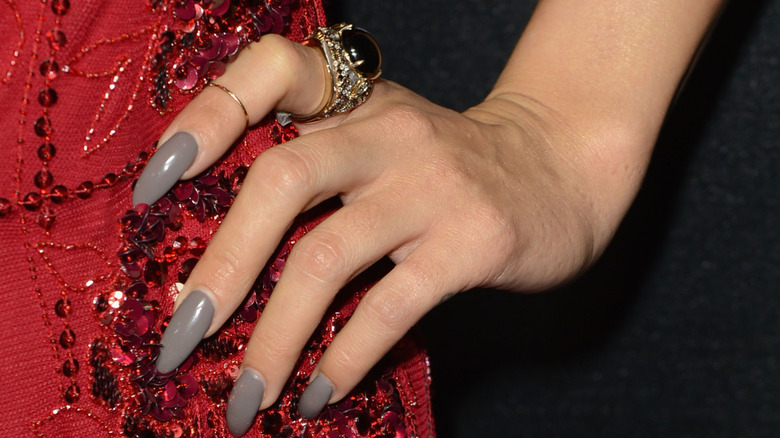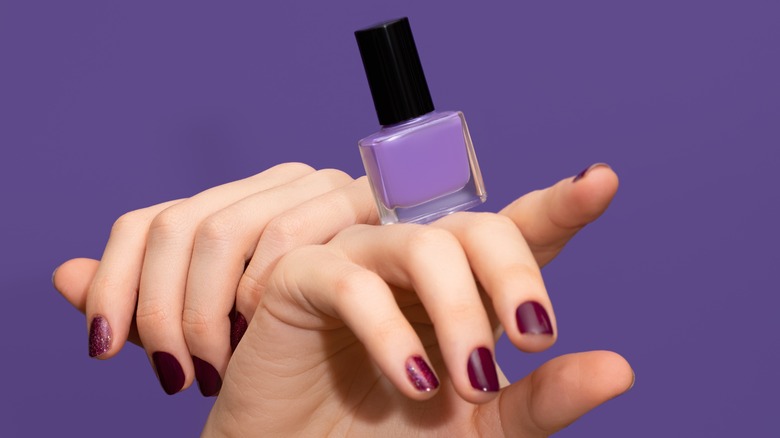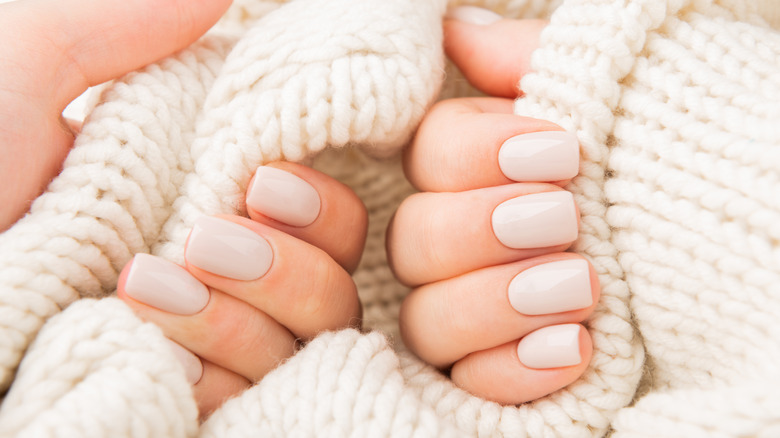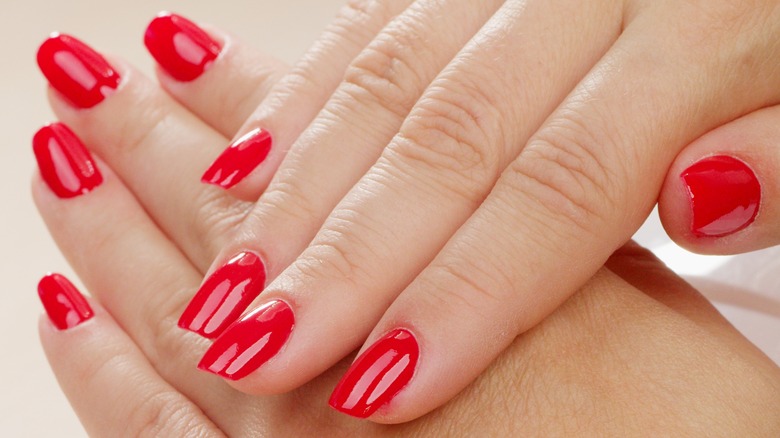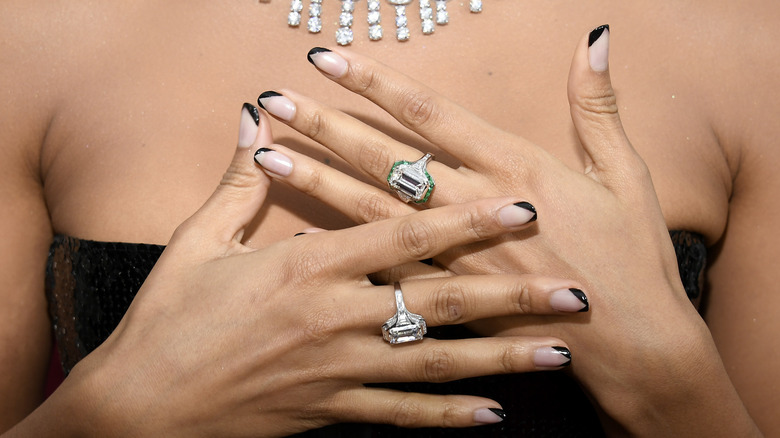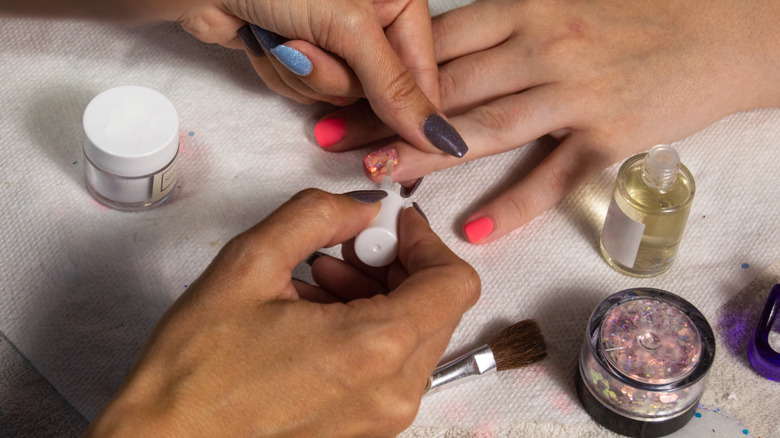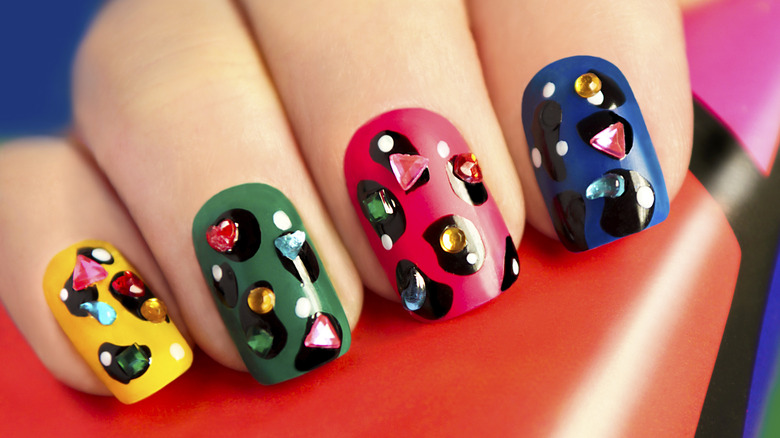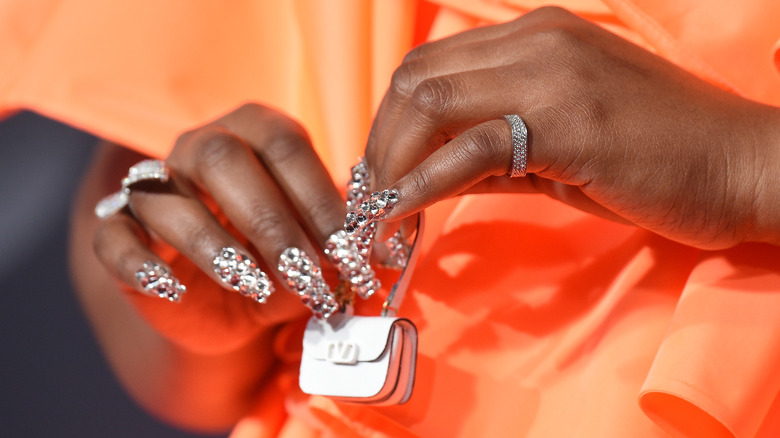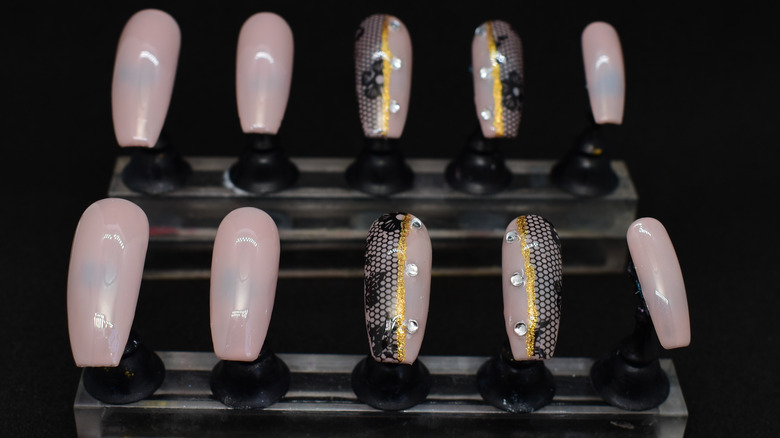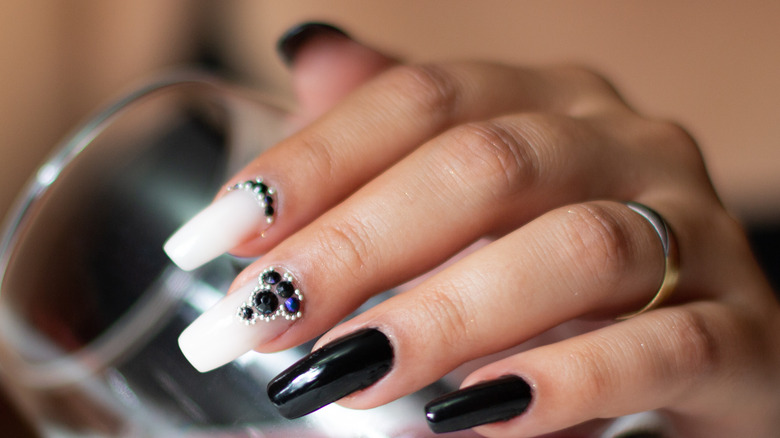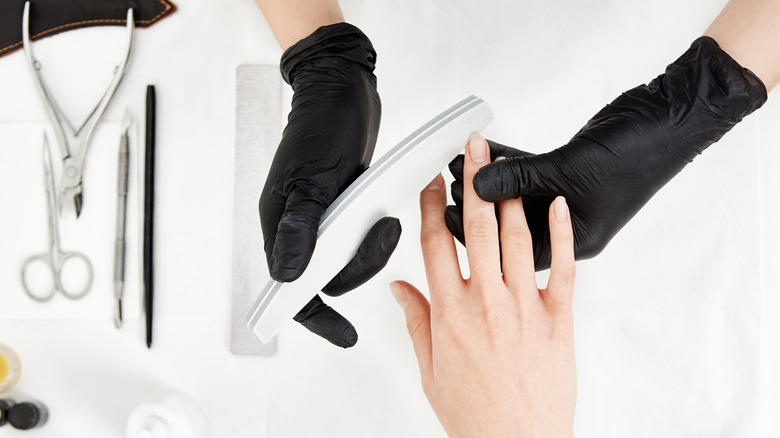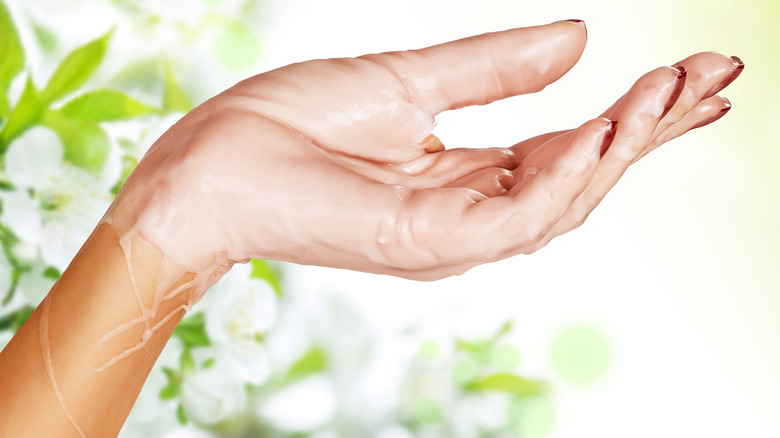The Ultimate Guide To Every Type Of Manicure
From the use of red car paint to the founding of Revlon in the 20th century, manicured nails have come a long way. However, nail adornments go back even further in time. The Babylonians colored their nails with kohl, and Cleopatra and the royal Egyptians stained theirs with Henna — supposedly, the darker the color, the more power you held in your hands (via Marie Claire).
Old Hollywood icons like Elizabeth Taylor and Rita Hayworth popularized the red talon look, matching it with their bold lipstick in the newly colorized moving pictures. Later, the '70s brought the production of more mellow hues to the scene and a return of the French manicure, as reported by Marie Claire.
By the '90s, the square shape was en vogue and patterns and designs took shape, paving the way for the surge of modern nail art, which has taken center stage with intricate designs by wildly talented artists. From 3D art to metallics, appliques to charms — not to mention the many shapes and types of manicures — one thing is for certain: the boom of the manicure is far from over.
The classic polish manicure
When most people think of getting a manicure, a classic polish manicure is often what comes to mind. These manicures typically run on the lower end of the cost scale, and involve trimming your nails and cuticles, filing, shaping, and buffing of the nails. Before your nails are painted, the nail technician will typically also have you soak your hands in warm, soapy water; however, some nail techs opt for dry manicures, which don't use soaking as part of the process.
In an interview with Refinery29, Lisa Jachno, a celebrity nail tech, discussed the benefits of skipping the warm soak. "Throughout my 30 years [in the industry] and thousands of hands I've groomed, I have found that soaking is one of the culprits to nail-polish chipping and peeling so quickly after a manicure." Instead of soaking, using oils or cuticle remover to soften the skin while avoiding impacting the nail can result in a longer-lasting manicure.
Regardless of whether your nail tech goes the wet or dry route, most nail techs will spend time clearing cuticles at the base of the nail before moving on to buffing the nail to prepare for the polish. Choosing your polish is one of the best parts — whether you go for a solid or a sparkle! Some salons will even offer to do nail art, or nail stamping, with regular polish, so you can have lots of fun with your classic polish manicure.
For a longer wear option, try out a gel manicure
Gel manicures are well-known (and beloved) for their lasting power and durability. The process is somewhat the same as a classic polish manicure — soak, trim, file, buff, and clean before starting the gel polish regimen.
For gel polish to set, a base coat is applied and cured under a UV light for 30 seconds or so. The next coat will be the color you chose, and that gets cured as well. The final step, unless you're doing nail art, will be the application of a shiny top coat, which seals everything in and ensures that two-week wearability with low chances of chipping.
While these manicures take the cake when it comes to longevity, they do come with some caveats to consider. Exposure to UV light is not good for the skin or even the nails. Some salons will provide gloves that shield your hands from the light, but using UV light is a necessary step in curing your gel manicure. Thankfully, your hands are only under the lamp for a few 30-second intervals during a whole manicure session, and you can wear sunscreen to prevent sun damage to your hands.
Another thing to consider when it comes to gel manicures: Because the polish is literally cured onto your nails, it requires proper care to remove and should, under no circumstances, be picked at as it can damage your nail beds. Be sure to schedule a removal appointment with your salon.
So, now what is shellac?
Shellac manicures are similar to gel in that they are also cured using a UV light. They are made up of an acrylic base with regular polish and are considered, by some, to be the safest of the gel options for your nails, according to Byrdie. Shellac is also formulated without some of the more harmful ingredients in major gel brands. Celebrity nail artist Julie Kandalec told InStyle, "The high level of lacquer in shellac means that there is zero damage to natural nails, and you still get a hard, high-gloss finish that resists chips, nicks, and smudges."
While gel and shellac are quite similar in wearability and durability, one major difference is the removal time. In an interview with Byrdie, nail expert Jan Arnold explained, "When acetone-based remover is applied, the coating actually breaks into tiny pieces and releases from the nail." This equals a much easier — and faster — removal time.
The many faces of the French manicure
The French manicure, also known as the half-moon technique, first gained traction in 1975 after Jeff Pink, the founder of Orly Nails, deemed it an elegant nail for actresses, models, and flappers, according to The Guardian. It became popular due to its subtle accentuation of the natural nail curve, and for the fact that this design can be easily executed using gel, acrylic, shellac, or regular polish. In recent years, the french tip has taken a fun turn into bold, colorful, and even chrome territories.
Celebs are getting in on the action too. Bella Hadid shared a picture of her sunshine yellow French manicure on Instagram in 2019, while actor Zazie Beetz sported a black french tip at the 92nd annual Academy Awards in 2020.
The French tip shape itself can also vary – from two-tone color gradients with either a lighter or darker tip to V-cut French manicures, which highlight the same nail shape as a traditional French manicure but with more severe angles. Additionally, the inverted French tip puts the usual half-moon design at the base of the nail, while the double French manicure places another line below the colorful French tip. No matter your style, the French manicure can work for you thanks to its numerous interpretations.
Are dip nails worth the hype?
Dip powder manicures are known for being long-lasting. This type of manicure uses a pre-colored acrylic powder that air-cures. First, a base, or primer, coat is applied to the natural nail. The fingernail is then either dipped into acrylic powder or the powder is brushed on top of the nail (the latter is far more hygienic if you're at a salon), layering until the right level of coverage is achieved. Next comes the activator coat, which is brushed on to activate the final curing – no UV lamp required.
And the reason they're so durable? Manicurist Deborah Lippmann told Allure, "Dip powders are bonded using a glue called cyanoacrylate, which is also the main ingredient in Krazy Glue." Thus, they are able to air-cure when the final layer is applied to the acrylic dip powder. It's essentially the same process as glue hardening.
Dip powder does have a downside, though. It is much harder to remove because it has hardened like glue. Similar to gel, the top layer needs to be filed off and then the nails will need to be soaked — sometimes up to 30 minutes — in an acetone solution to soften the mixture for removal. Nevertheless, dip powder nails can look great for up to a month, according to the American Academy of Dermatology Association.
Acrylic overlay can help to strength natural nails, without adding length
During an acrylic overlay manicure, a thin layer of acrylic powder and an activating liquid is applied to the natural nail. It typically doesn't add length because there is no use of plastic extensions, but it can provide a strong base for any kind of decoration or embellishments. Removal requires thorough filing and a long soak in acetone solution for the acrylic gel to properly be scraped from the natural nail. Acrylic overlay holds its shape and strength for longer than classic polish on a wearer's natural nails. Unlike a gel manicure, acrylic nails don't require UV light to cure and can instead air-cure.
While long nails are definitely a style that holds its own, the acrylic overlay option gives the wearer a good jumping-off point for beautiful, albeit shorter, nails. If you're in need of short nail inspo, check out popular celebrity nail artist Elle Gertstein on Instagram. She features lots of fun designs and styles that work well on tiny talons.
Fun with acrylic extensions, the accessory of the season
Perhaps the most trendy of the manicure types is the gel extension manicure. It features the addition of either a full-coverage nail or a plastic tip extension. These extensions are glued to the natural nail through the use of bonding nail glue or a curable slip coat before applying the steps of a gel manicure. This creates a blank canvas for artistry. Gel extensions can be removed by soaking the nails in acetone, according to L'Oréal Paris
Extensions can come in quite a few shapes and can be filed to fit the needs of the wearer. Coffin-shaped extensions are especially popular. Kylie Jenner and Lizzo are just two celebrities who have worn this striking nail style. Additionally, Rosalía even went so far as to feature microchips and circuit boards upon her coffin-shaped nails (via Nylon).
Other popular nail shapes include almond, oval, round, and stiletto. Wilder looks include flared, lipstick, arrowhead, and edge shapes — which feature asymmetry, wider tips, and particularly pointed edges (per Allure). With all the options and directions in which to take a design, it's easy to see why longer nails have become an added, deliberate accessory for many who enjoy having fun with their nails.
Press-on nails
During lockdown, many nail-wearers couldn't visit their local salon and thus turned to at-home, press-on manicures (via Refinery29). Press-on nails come in a variety of colors, shapes, and designs. Many find them simple to apply, as all that is required is a drop of nail glue. However, some kits feature peel-and-stick press-on nails, requiring you to simply peel away the backing and stick the nail to your clean, natural nail. Press-on kits typically range from $10 to $30, but can cost more depending on customizations. Press-on nails are a great option for those worried about the damage caused by other manicures. Nail artist Gina Edwards told Allure, "The biggest benefit of a press-on is that you are in charge of your nail health."
The likes of Ariana Grande and Chrissy Teigan showcased their DIY manicures while at home in 2020, with other popular companies touted reusable and easily removable press-ons. Blake Lively even wore a set of $8 press-on nails to the Met Gala in 2022 — the Met Gala!
VinyLux offers gel quality without a complicated removal process
Vinylux manicures have an interesting selling point. They are marketed as the polish that can last a week without chipping, with the durability of other gel manicures (via Refinery29). But unlike gel polish, Vinylux does not require a base coat to adhere to your nails. All it needs is a couple of layers of polish and a final top coat. Glamour praises Vinylux for its ability to last a full week without needing to be UV light-cured or even applied by a professional. Vinylux can be purchased online — although some nail salons will also incorporate it into your manicure.
Standard acetone nail polish remover can do the trick as far as removal goes, per Glamour. However, Refinery29's prior senior beauty editor Megan McIntyre, did find it difficult. "I really had to work the cotton pad over my nails and rub hard — at one point I was basically scraping the polish off. ... But, even through all of that, my nails didn't look all that worse for the wear. There was no peeling, splitting, or breakage from the polish, which is definitely noteworthy for my easily damaged digits."
While it takes some elbow grease to remove the polish with acetone, it's still pretty easy to remove in comparison with its gel and acrylic counterparts.
The natural-looking (yet controversial) nail trend
The Russian manicure, which started trending on Tiktok in 2022, focuses specifically on the cuticle and half-moon section of the nail bed. It can take up to three hours to complete and requires a level of precision with an e-drill (electric file) as well as an understanding of how to properly file around the base of the nail bed.
On a dry nail, the technician will use scissors to cut the cuticles back to the epicuticle, pulling away any dead skin from the rest of the nail (via Reader's Digest). After this, the nail is filed and prepped for the next steps in the manicure — base coat and polish application.
However, there is a lot of controversy surrounding this manicure. Medical experts have warned that removing the epicuticle can expose the nail to increased bacterial infection, according to Refinery29. Additionally, Dr. Jeanine Downie, a board-certified dermatologist, told Reader's Digest, "It can also permanently alter the structure of your nail, weaken your nail, and cause bleeding." Needless to say, while the results of the Russian manicure (which costs around $70 to $125) may be aesthetically pleasing, it should only be done by a practiced professional, if at all.
A salon treatment step to add to your manicure
The Paraffin manicure is a salon treatment to enrich your hands after, or sans, polish. This treatment involves dipping the whole hand in warm paraffin wax, a combo of beeswax and petroleum (via PureWow). The wax can be mixed with soothing essential oils. Once your hand is dipped, the wax will stay on for between 5 to 30 minutes, depending on the salon and the specific treatment. Once the wax has dried, the technician will peel the layers away, massaging in the oils from the wax that are known to lock in moisture.
Paraffin wax treatments are great for dry, cracked hands and are thought to improve circulation and relieve symptoms of arthritis, muscle aches, and other joint issues, according to Healthline. After getting your nails done at the salon, it may be worth looking into adding a paraffin wax dip. Alternatively, you can opt to do it yourself.
